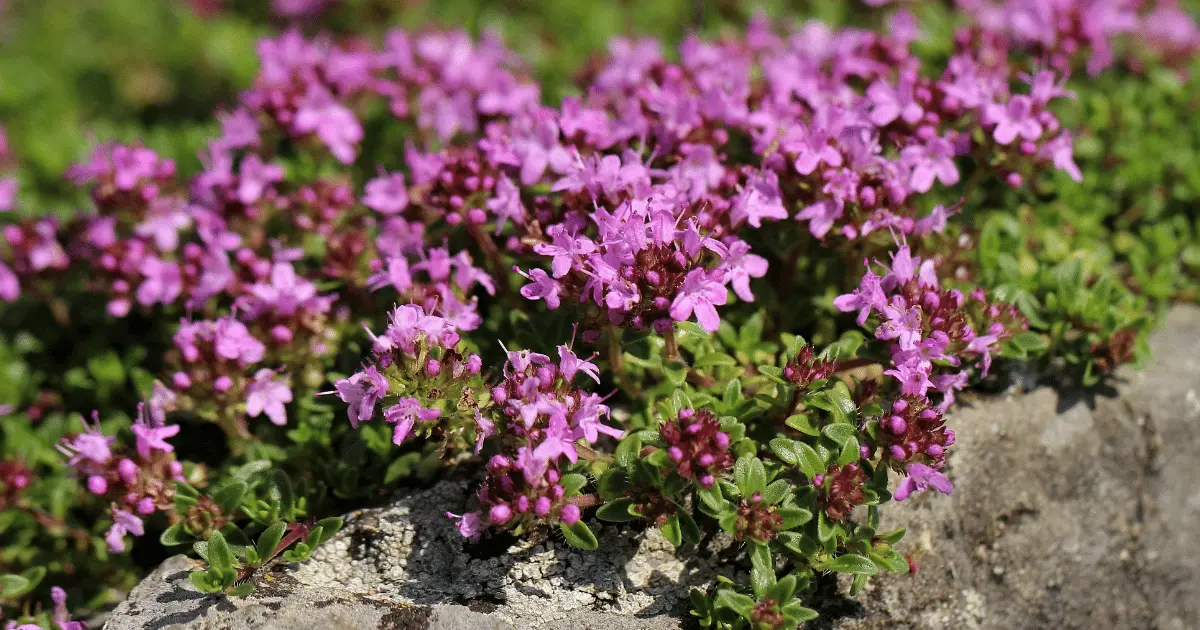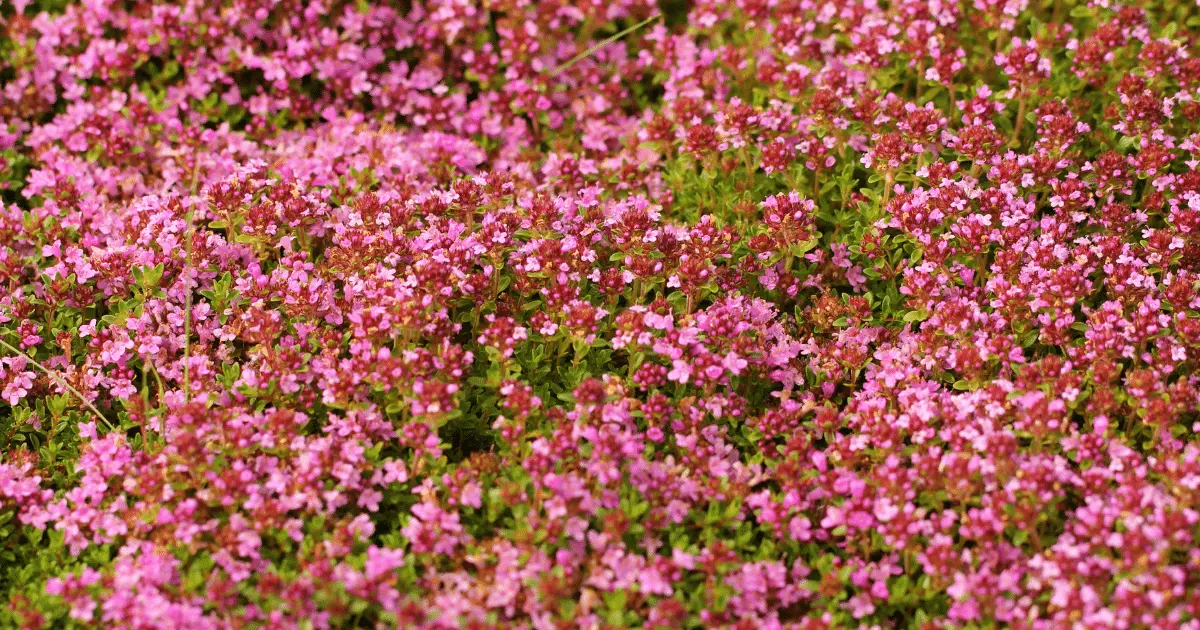The spicy smell of creeping Thyme when you run your hands over them or crush them makes it an excellent choice for a sensory garden. Red creeping Thyme is particularly well-liked for its vivid blooms, which cover the ground in deep wine-to-lavender hues.
Red creeping Thyme is a perennial herbaceous plant from the mint family that tolerates drought and enjoys sunlight; despite having a delicate appearance, this Thyme adapts well to a variety of well-draining situations and can even stand some mild foot traffic. This makes it a low-maintenance plant that is also good for beginners. In more temperate climates, Red creeping Thyme is evergreen, and the leaves turn bronze in the fall.
Growing Red Creeping Thyme: A Guide
Red Creeping Thyme is a Lamiaceae (mint) family low-growing, creeping, evergreen perennial native to Turkey, Greenland, Asia, and Europe. Red Creeping Thyme is the mother of Thyme; other plants in the Labiatae family include rosemary, wild marjoram, oregano, peppermint, basil, and European pennyroyal, lavender; they all possess a similar pleasant smell.
You may cultivate red creeping Thyme from seeds or plugs. Landscapers purchase plugs in quantity because they are the smaller transplants most economical to plant in big numbers. Red creeping Thyme multiplies and has self-seeding properties; once grown outside, creeping thyme self-seeds and continues to thrive and embellish gardens.
Here is all you need to cultivate Red Creeping Thyme if you consider adding this vibrant plant to your yard.
What Does Red Creeping Thyme Need To Grow Well?

Despite being a low-maintenance plant, Red Creeping Thyme has some requirements that need to be met before blooming occurs. Those requirements include the following;
- Well-Drained Soil
Red creeping Thyme thrives in well-draining soil, particularly in containers, as it is prone to root rot when planted in moist soil. Whether planting red creeping thyme seeds or plugs, moisten the ground beforehand.
Thyme hates nitrogen-filled soil; they enjoy sandy, humusy soils with a ph range from 6-7; they also leave up to 15 inches of space when planting as they spread when growing.
2) Watering
Since it is a drought-tolerant herb plant, it is okay without watering it regularly or daily. Note that water logging kills Red Creeping Thyme and other low-maintenance plants. Hence, it’s significant to provide an appropriate watering method for the Red Creeping Thyme until they are more rooted
3) Planting seed/Cutting
If planting with seeds, scatter them equally around your desired location and cover them with a thin layer of well-draining soil. This can be done outdoors in your nursery, and you can also grow seeds indoors in spring, and in just a few days, tiny seedlings will pop up.
After that, you can divide Red Creeping Thyme by plucking up a root ball and splitting it in two as the plant grows. Also, replant both parts and ensure the hole is twice as large as the ball.
One of the beautiful things about Red Creeping Thyme is its germination. You can start with barely 30 seeds in the packet and end up with over 100 seedlings. Spring or early autumn are the finest times to divide and plant Red Creeping Thyme.
If you need help getting seeds, you can get Red Creeping Thyme seeds from Amazon
4) Propagation
Red creeping Thyme propagates easily from stem cuttings. Take a clip from the plant, dip in root in hormone and plant it in a pot of well-drained soil.
5) Fertiliser
The optimum time to fertilize Red Creeping Thyme is early summer before the plant begins to grow. Use an all-purpose houseplant fertilizer during the growing season to promote healthy development.
In the spring, fertilize once a month aids the plant’s healthy growth.
6) Sun
Among other thyme kinds, Red Creeping Thyme loves the sun; although Red Creeping Thyme may survive in shadow, planting it in a sunny location will yield the best results.
Dark green leaves are produced when they are planted in a shaded location.
7)Transplanting
You can dip the Red creeping thyme cutting or seeds in rooted hormone powder before planting them in the ground if you germinate them indoors in trays.
Until it’s time to transfer them, keep the plant moist. Place the planting tray where it can receive four hours of sunlight while covering it with plastic to help preserve moisture.
While planting firm in the ground around the plant roots when transplanting plugs, dig out an area large enough to accommodate the size of plugs you have.
Plant plugs in rows between 15 inches and two feet when transplanting them. Thus, the plants have plenty of room to spread out evenly rather than having a patchwork appearance.
Caring For Red Creeping Thyme

Red creeping Thyme is a low-maintenance plant with moderate warmth, water, and good soil. Red Creeping Thyme will produce beautiful and healthy foliage as it prefers well-drained soil and sun.
- Pruning
Over time regular pruning at the end of each growing season will be needed as pruning red creeping thyme plants allows them to continue producing soft, verdant stems that blossom profusely.
Do away with the old and weak woods from your Red Creeping Thyme, and this process should be done 2-3 times a year. The initial pruning should be done in early spring. This process of cutting stems back promotes foliage development.
2)Get Rid of Rotten Roots
Over watering causes root rot in red creeping Thyme; remove the damaged plant and brown-colored roots.
3) Use Organic Fertiliser
Fertilizing is optional when planting into fertile soil. However, proper organic fertilizer boosts growth, especially in deficient soil.
4)Winter Protection
Depending on where you live, you can cover the plant with a thin layer of sand throughout the winter. However, to reduce rotting, ensure that the location has enough drainage.
5) Examine Regularly
Cut away any weak or dis-colored plant portions after carefully examining them. Soap insecticide should be sprayed on the plant in case of pest infestation.
Common Problems with Red Creeping Thyme
Bees and ladybugs adore red creeping Thyme. You would believe insects don’t affect it, but some do. For example, Aphids can be very destructive to Red Creeping Thyme, especially indoors, but Lady bugs attack Aphids when outside.
Here are some common issues with Red Creeping Thyme.
- Insects
Red creeping Thyme is repellent to pests and diseases, but a few can be problematic such as Aphids, creepy crawlies, and fungus gnats. If you observe any of these issues, you can treat them with a pesticide or fungicide, or insecticide soap.
2. Root Rot
A common problem with Red Creeping Thyme is avoiding overwatering plants to prevent this.
3. Encroaching on other plants
When growing red creeping Thyme near other plants, bear in mind that it spreads quickly and can creep over the roots of surrounding plants. You can prune the stems that are encroaching on other plants.
Benefits Of Red Creeping Thyme
Red creeping Thyme is an excellent plant. In addition to its fantastic combination of evergreen leaves and colored foliage, it can be used for making mint teas, has health benefits, and helps control weeds.
- Prevents Pests
Red Creeping Thyme helps prevent insects and worms and has natural antibacterial characteristics.
2. Wonderful Aroma
While upright thyme species are more well-known for their culinary value and significant yields, creeping thyme shares some of that aroma and flavor, making it an ideal kitchen-garden companion.
3. Beautiful Ground cover
Red creeping Thyme creates a superb ground cover. When it blooms, it forms an excellent attractive foliage ground cover. It also helps to control and reduce the growths of weeds and helps to attract helpful insects with its beautiful color.
4. Prevents Erosion
Red Creeping Thyme helps to moisturize surroundings and covers the soil, and it helps to prevent Erosion.
5. Culinary Herb
Red Creeping Thyme helps to cure cough and respiratory issues; it has served as a remedy for other illnesses.
Red Creeping Thyme enjoys a lot of warmth, light, dry soil, and full, bright sun, similar to lavender circumstances. Although it can endure less-than-ideal circumstances, it never flourishes in dark shade or dense soil.
Don’t overwater your Red Creeping Thyme because that will cause it to die.
